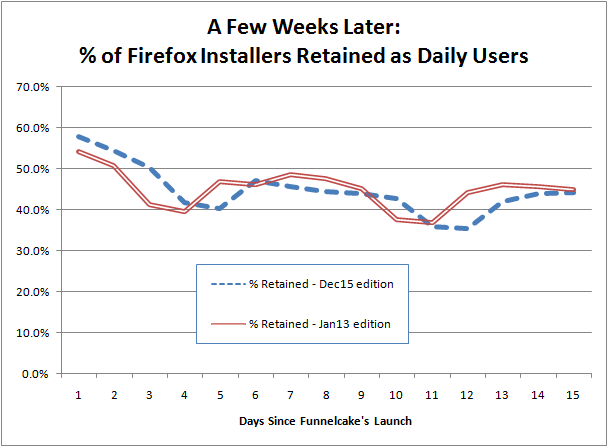Thanks to recent editions of Funnelcake, along with two editions from 2007, we can now start to think about our ability to retain Firefox users over time. In other words, if a user downloads and installs Firefox today, what are the odds of that user firing up their Firefox browser one month from today? six months from today? and has our retention ability and the experience of Firefox users changed over time?
Answering such questions can better inform our decision making – decision making across the Mozilla Project, from product decisions, to UI and UX decisions, to community specific decisions.
With this introduction aside, let’s dive into the analysis and insights. First, let’s look at our most recent Funnelcake cohorts, i.e., those users who downloaded Firefox on Monday, December 15th and on Tuesday, January 13th. The chart below shows that of those who successfully installed Firefox, the percentage who actively used it on a particular day since then:
The rate at which these two groups of users continued using Firefox on a day-to-day basis is fairly similar. The group who installed Firefox on December 15th was affected by the holiday season, so we cheated a bit by ignoring about ten days around that time period to avoid having seasonality take us away from the broader story here. You’ll notice that the peaks and valleys are slightly off, which is due to the day of week factors being off by one day.
As we’ve noted previously, Firefox is very, very sticky. The fact that so many new users continue using it each and every day is an amazing testament to the strength and health of our communities.
Taking one other look at this data, we can make a comparison with similar groups of new users who first started using Firefox back in the fall of 2007. As the internet population has grown and as Firefox has improved, has our ability to retain new users changed in any way? Looking at previous analysis of those users – here and here – you’ll notice that at the 30-day mark after installation, we were seeing about 49% of original installers as active daily users. Our new data above from the December and January cohorts suggests this rate is close to 44%.
How should we interpret this difference?
- First, we should be careful here. The two sets of installation numbers (from 2007 and from present day) are coming from two different web analytics solutions. The difference could be attributable solely to the measurement methodologies or reporting abilities of such solutions.
- Second, if we are to believe this difference could be real, it could suggest that as Firefox has reached more mainstream internet users (e.g, my parents), our ability to retain new users has changed.
Your thoughts?
